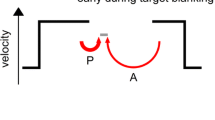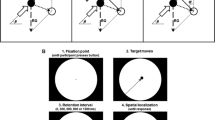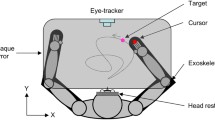Abstract
Coherent global motion is a compelling illusion of visual motion that is seen as the result of spatially and successively presented stimuli that are, in fact, stationary. In the present study the threshold perception of global coherent motion was measured using random-dot kinematograms in a group of normal observers and a group with mixed symptoms in schizophrenia who also participated in a companion study on smooth pursuit eye movement (Slaghuis et al. in Exp Brain Res, 2007). The velocity of coherent motion target stimuli was produced by varying the spatial step-size (Δs) between dots to create three target velocities (6.0, 12.0 and 24.0 deg/s) which were measured at three target stimulus densities (100, 200, and 400 dots/deg2). A staircase procedure was used to determine the threshold for the number of target dots that was needed to move in the same direction to detect the direction of motion and which were plotted amongst a field of randomly moving visual noise dots. The findings demonstrate that in comparison with normal observers, the threshold for the perception of coherent motion in the group with schizophrenia was significantly higher at the lowest target velocity of 6.0 deg/s but not at target velocities of 12.0 and 24.0 deg/s. Stimulus density was found to have a significant effect on the perception of coherent motion, but it had no differential effect on performance in the groups. An examination of relationships between coherent motion and smooth pursuit eye movement in the companion study (Slaghuis et al. in Exp Brain Res, 2007) revealed significant, negative, correlations between coherent motion and apparent motion smooth pursuit eye velocity at target velocities of 6.0, 12.0 and 24.0 deg/s in the group with schizophrenia, but no such relationship was found in normal observers. It was concluded that the significant reduction in sensitivity for the perception of coherent motion at the lowest target velocity of 6.0 deg/s in the group with schizophrenia is consistent with an impairment in the detection of visual motion at a local level and in parallel for all parts of the image at striate and extrastiate levels of visual processing.



Similar content being viewed by others
References
Andreasen NC (1981) Scale for the assessment of negative symptoms (SANS). University of Iowa, Iowa City
Andreasen NC (1983) Scale for the assessment of positive symptoms (SANS). University of Iowa, Iowa City
Anstis SM (1970) Phi movement as a subtraction process. Vision Res 10:1411–1430
Balogh DW, Merritt RD (1987) Visual masking and the schizophrenia spectrum: interfacing clinical and experimental methods. Schizophr Bull 13:679–698
Barnes GR, Asselman PT (1992) Pursuit of intermittently moving targets in the human. J Physiol 445:617–637
Braddick O (1974) A short-range process in apparent motion. Vision Res 14:519–527
Butler PD, Javitt DC (2005) Early-stage visual processing deficits in schizophrenia. Curr Opin Psychiatry 18:151–157
Butler PD, Schechter I, Zemon V, Schwartz SG, Greenstein VC, Gordon J, Schroeder CE, Javitt DC (2001) Dysfunction of early-stage visual processing in schizophrenia. Am J Psychiatry 158:1126–1133
Chen Y, Palafox GP, Nakayama K, Levy DC, Matthysse S, Holzman PS (1999a) Motion perception in schizophrenia. Arch Gen Psychiatry 56:149–154
Chen Y, Levy DL, Nakayama K, Matthysse S, Palafox GP, Holzman PS (1999b) Dependence of impaired eye tracking on deficient velocity discrimination in schizophrenia. Arch Gen Psychiatry 56:155–161
Chen Y, Nakayama K, Levy DC, Matthysse S, Holzman PS (2003) Processing of global but not local motion direction is deficient in schizophrenia. Schizophr Res 61:215–227
Chen Y, Levy DL, Sheremata S, Holzman PS (2004) Compromised late-stage motion processing in schizophrenia. Biol Psychiatry 55:834–841
Churchland MM, Lisberger SG (2000) Apparent motion produces multiple deficits in visually guided smooth pursuit eye movements in monkeys. J Neurophys 84:216–235
Ciuffreda KJ, Tannen B (1995) Eye movement basics for the clinician. Mosby, St Louis
De Angelis CG, Ohzawa I, Freeman RD (1995) Receptive field dynamics in the central visual pathways. Trends Neurosci 18:451–458
De Valois RL, Cottaris NP, Mahon LE, Elfar SD (2000) Spatial and temporal receptive fields of geniculate and cortical receptive fields and directional selectivity. Vision Res 40:3685–3702
Diefendorf AR, Dodge R (1908) An experimental study of the ocular reactions of the insane from photographic records. Brain 31:451–489
Edwards M, Badcock DR (1994) Global motion perception: interaction of the ON and OFF pathways. Vision Res 34:2849–2858
Edwards M, Badcock DR (1996) Global motion perception: interaction of chromatic and luminance signals. Vision Res 36:2423–2431
Holzman PS, Proctor LR, Hughes DW (1973) Eye tracking patterns in schizophrenia. Science 181:179–181
Julesz B (1970) Foundations of cyclopean perception. University of Chicago Press, Chicago
Katcher BS, Young LY, Koda-Kimble MA (1988) Applied therapeutics: the clinical use of drugs, 4th edn. Applied therapeutics, Vancouver, Canada
Kay SR, Opler LA, Fiszbein A (1991) Postive and negative syndrome scale. Multi-Health Systems, Inc. 908 Niagra Falls Boulevard, North Tonawanda, New York, US
Kim D, Wylie G, Pasternak R, Butler P, Javitt DC (2006) Magnocellular contributions to impaired motion processing in schizophrenia. Schizophrenia Res 82:1–8
Krauszlis RJ, Lisberger SG (1994) Temporal properties of visual motion signals for the initiation of smooth pursuit eye movements in monkeys. J Neurophys 72:150–162
Li CR (2002) Impaired detection of visual motion in schizophrenic patients. Prog Neuropsychopharm Biol Psychiatry 26:929–934
Lisberger SG, Morris EJ, Tychsen L (1987) Visual motion processing and sensory motor integration for smooth pursuit eye movements. Annu Rev Neurosci 10:97–129
Morris EJ, Lisberger SG (1987) Different responses to small visual errors during initiation and maintenance of smooth pursuit eye movements in monkeys. J Neurophys 58:1351–1369
Nealey TA, Maunsell JHR (1994) Magnocellular and parvocellular contributions to the responses of neurones in the macaque striate cortex. J Neurosci 14:2069–2079
Nelson HE (1983) National Adult Reading Test (NART) Nfer-Nelson Publishing Co, Windsor
Newsome W, Pare E (1988) A selective impairment of motion perception following lesions of the middle temporal visual area (MT). J Neurosci 8:2201–2211
Newsome W, Wurtz R, Dursteler M, Mikami A 1985a Deficits in visual motion processing following ibotenic acid lesions of the middle temporal visual area of the macaque monkey. J Neurosci 5:825–840
Newsome W, Wurtz R, Dursteler M, Mikami A (1985b) Deficits in visual motion processing following ibotenic acid lesions of the middle temporal visual area of the macaque monkey J Neurosci 5:825–840
Rudolf KK, Ferrera T, Pasternak V (1994) A reduction in the number of directionally selective neurons extends the spatial limit for global motion perception. Vision Res 24:3241–3251
Sawatary A, Callaway EM (1996) Convergence of magnocellular and parvocellular pathway layers in layer 4B of macaque primary visual cortex. Nature 380:442–446
Schuck JR, Lee RG (1989) Backward masking, information processing, and schizophrenia. Schizophr Bull 15:491–500
Schwartz BD, Maron BA, Evans WJ, Winstead DK (1999) High velocity transient visual processing deficits diminish ability of patients with schizophrenia to recognise objects. Neuropsychiatry Neuropsychology Behav Neurol 12:170–177
Slaghuis WL (1998) Contrast sensitivity for stationary and moving spatial frequency gratings in positive- and negative-symptom schizophrenia. J Abnorm Psychol 107:49–62
Slaghuis WL, Bakker VJ (1995) Forward and backward masking of contour by light in positive- and negative symptom schizophrenia. J Abnorm Psychol 104:41–54
Slaghuis WL, Bowling AC, French R (2005) Linear smooth pursuit eye movement and directional motion contrast sensitivity in positive- and negative-symptom schizophrenia. Exp Brain Res 166:89–101
Slaghuis WL, Hawkes A, Holthouse T, Bruno R (2007) Eye movement and visual motion perception in schizophrenia I: apparent motion evoked smooth pursuit eye movement reveals a hidden dysfunction in smooth pursuit eye movement in schizophrenia. Exp Brain Res (in press)
Snowden RJ, Baddick O (1989) The combination of motion signals over time. Vision Res 29:1621–1630
Stuve TA, Friedman L, Jesberger JA, Gilmore GC, Strauss ME, Meltzer HY (1997) The relationship between smooth pursuit performance, motion perception and sustained visual attention in patients with schizophrenia and normal controls. Psychol Med 27:143–152
Takeuchi T, De Valois KK, Hardy JL (2003) The influence of colour on the perception of luminance motion. Vision Res 43:1159–1175
Tychsen L, Lisberger SG (1986a) Maldevelopment of visual motion processing in humans who had strobismus with onset of infancy. J Neurosci 6:2495–2508
Tychsen L, Lisberger SG (1986b) Visual motion processing for the initiation of smooth-pursuit eye movements in humans. J Neurophys 56:953–968
Venables PH (1964) Input dysfunction in schizophrenia. In Maher B (ed) Advances in experimental personality research, vol 1. Academic Press, New York
Wertheim AH, Van Gelder P, Peselow LE, Cohen N (1985) High thresholds for movement perception in schizophrenia may indicate abnormal axtraneous cerebelar noise levels of cortical verstibular activity. Biol Psychiatry 20:1197–1210
Wetherill GB, Levitt H (1965) Sequential estimation of points on a psychometric function. Br J Math Stat Psychol 18:1–10
Williams DW, Sekuler R (1984) Coherent global motion percepts from stochastic local motion. Vision Res 24:55–62
Acknowledgment
We gratefully acknowledge the cooperation of the Tasmania Department of Health Division of Psychiatry, and all observers who participated willingly and generously to this study. This project was supported by an IRGS grant from the University of Tasmania in 2000.
Author information
Authors and Affiliations
Corresponding author
Rights and permissions
About this article
Cite this article
Slaghuis, W.L., Holthouse, T., Hawkes, A. et al. Eye movement and visual motion perception in schizophrenia II: global coherent motion as a function of target velocity and stimulus density. Exp Brain Res 182, 415–426 (2007). https://doi.org/10.1007/s00221-007-1003-3
Received:
Accepted:
Published:
Issue Date:
DOI: https://doi.org/10.1007/s00221-007-1003-3




